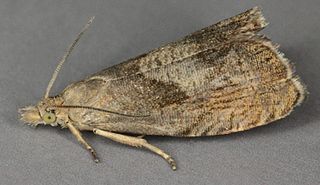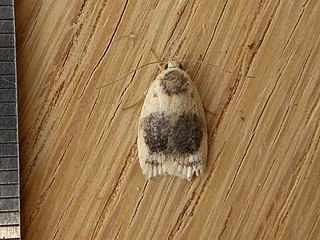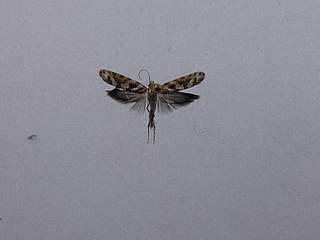
Dichrorampha simpliciana is a moth of the family Tortricidae. It is found in Europe and the Near East.

Garrha ocellifera is a moth of the family Oecophoridae. It is found in Australia, where it has been recorded from Queensland, New South Wales, the Australian Capital Territory, Victoria and Tasmania.

Phycomorpha metachrysa, the milktree fruit moth, is a species of moth in the Copromorphidae family. It is endemic to New Zealand and has been found in the North and South Islands. The larvae feed on the fruit of species in the genus Streblus including Streblus heterophyllus. This adults of this species is on the wing from October to April.

Pyrgotis eudorana is a species of moth of the family Tortricidae. It is endemic in New Zealand and has been observed in both the North and South Islands. However it is regarded as a rare insect. This species inhabits native forest. Larvae exclusively feed on Muehlenbeckia australis and adults are on the wing from November to April. Adults are attracted to light.

Nacoleia mesochlora is a moth in the family Crambidae. It was described by Edward Meyrick in 1884. It is found in Australia, where it has been recorded from Queensland, the Northern Territory, New South Wales, Victoria, South Australia and Western Australia.
Euchaetis endoleuca is a moth in the family Oecophoridae. It was described by Edward Meyrick in 1888. It is found in Australia, where it has been recorded from South Australia and Western Australia.
Garrha pseudota is a moth in the family Oecophoridae. It was described by Oswald Bertram Lower in 1901. It is found in Australia, where it has been recorded from Queensland.
Dichomeris viridescens is a moth in the family Gelechiidae. It was described by Edward Meyrick in 1918. It is found in Assam, India.
Ardozyga acroleuca is a species of moth in the family Gelechiidae. It was described by Edward Meyrick in 1904. It is found in Australia, where it has been recorded from New South Wales and Victoria.
Ardozyga deltodes is a species of moth in the family Gelechiidae. It was described by Oswald Bertram Lower in 1896. It is found in Australia, where it has been recorded from Victoria and New South Wales.
Monochroa robusta is a moth of the family Gelechiidae. It was described by Annette Frances Braun in 1921. It is found in North America, where it has been recorded from Ohio and South Carolina.
Lethata aromatica is a moth of the family Depressariidae. It is found in Brazil and Colombia.
Lethata satyropa is a moth of the family Depressariidae. It is found in French Guiana.
Cerconota impressella is a moth of the family Depressariidae. It is found in Brazil (Para), Peru, and the Guianas.
Enchocrates picrophylla is a moth in the family Depressariidae. It was described by Edward Meyrick in 1886. It is found in Australia, where it has been recorded from South Australia and New South Wales.
Eupselia hypsichora is a moth in the family Depressariidae. It was described by Edward Meyrick in 1906. It is found in Australia, where it has been recorded from Western Australia.
Eretmocera dioctis is a moth of the family Scythrididae. It was described by Edward Meyrick in 1897. It is found in Australia, where it has been recorded from Queensland, New South Wales and Western Australia.
Imma monocosma is a moth in the family Immidae. It was described by Alexey Diakonoff and Yutaka Arita in 1979. It is found on the Japanese islands of Kyusyu and Honshu.

Trachypepla lichenodes is a moth of the family Oecophoridae first described by Edward Meyrick in 1883. It is endemic to New Zealand and has been found in both the North and South Islands. It inhabits native forest and adults of this species are on the wing from November to January. The adult moths are similarly coloured to native lichen species however this colouration is variable in the extent and depth on the forewings.

Chrysorthenches porphyritis is a species of moth of the family Plutellidae. It was first described by Edward Meyrick in 1885 and is endemic to New Zealand. This species can be found on both the North and South Islands in open native forest and scrub at altitudes from sea level up to 1370 m. The larvae feed on Podocarpus laetus, P. totara, P. nivalis, and Phyllocladus alpinus. The larvae create a shelter by loosely spinning together the leaves of its host plant and can be found feeding in groups. The pupa is formed inside a thin cocoon. Hudson was of the opinion that this species had two broods a year. Adult moths are on the wing all year round. The adults of this species, particularly the female, are variable in colouration and in forewing pattern.








